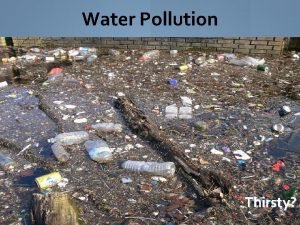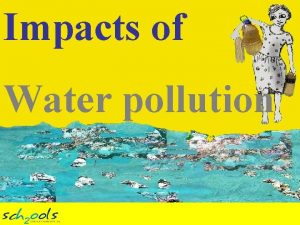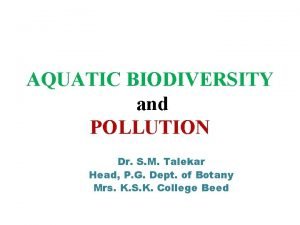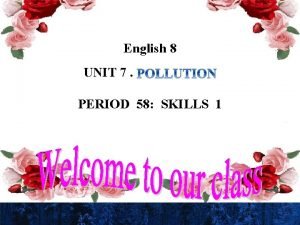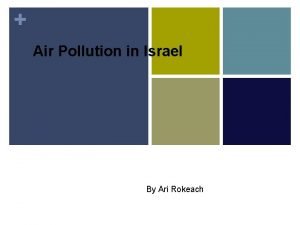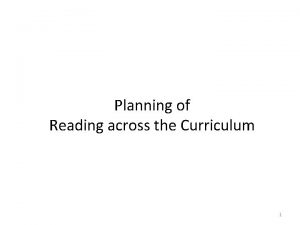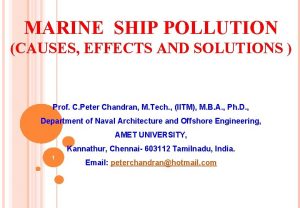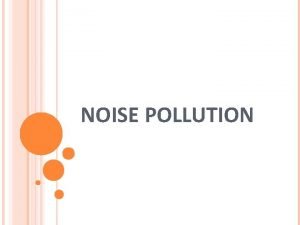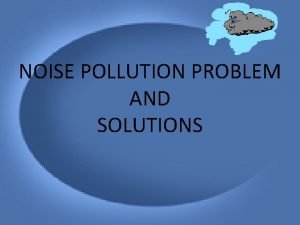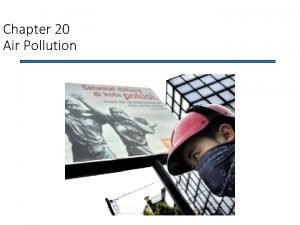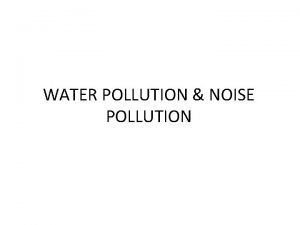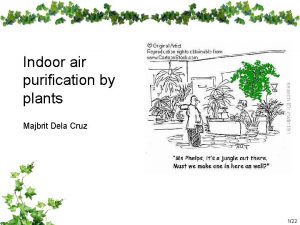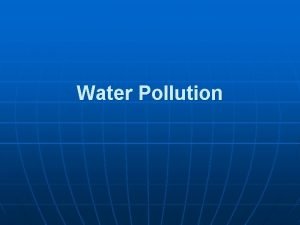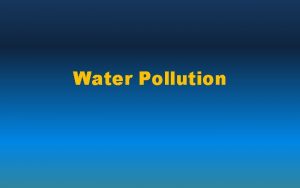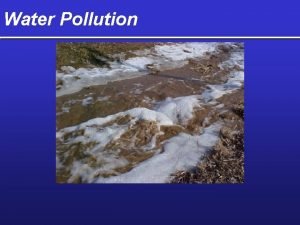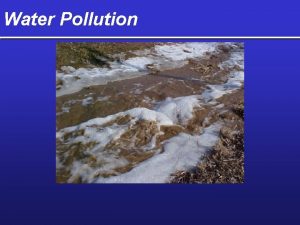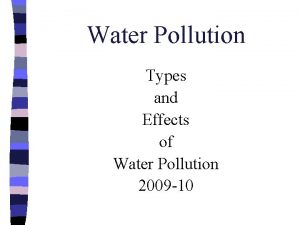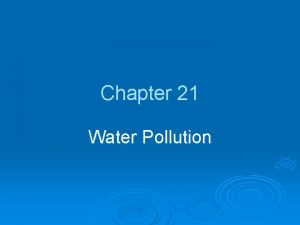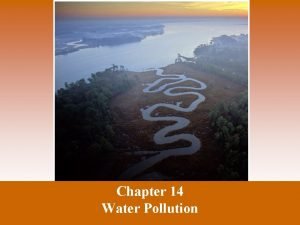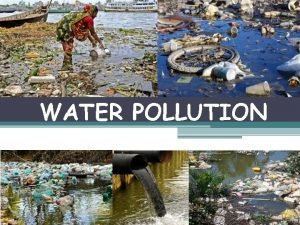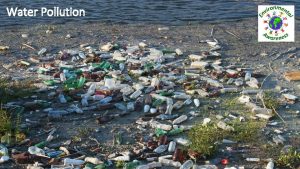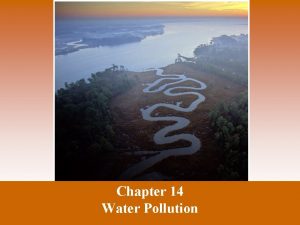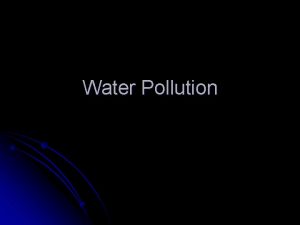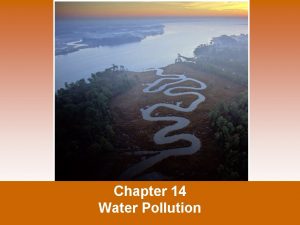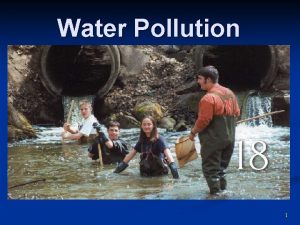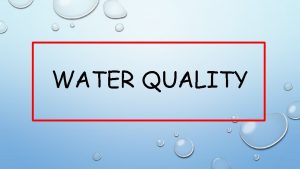Water Pollution Water Pollution Types Effects and Sources


















- Slides: 18

Water Pollution

Water Pollution: Types, Effects, and Sources n What is water pollution? n Major types of pollutants, sources and effects n Point and nonpoint sources n Is the water safe to drink?

Major Categories of Water Pollutants n Infectious Agents n • Nitrates, Phosphates, • Source: Sewage, manure, agricultural and landscaping runoff • Bacteria, Viruses, Protozoa, Parasitic Worms • Source: Human and animal waste n Oxygen-Demanding Waste n Inorganic Chemicals • Acids, Metals, Salts • Sources: Surface runoff, Industrial effluent, household cleansers n Radioactive Materials • • Iodine, radon, uranium, cesium, thorium Source: Coal & Nuclear Power plants, mining, weapons production, natural Organic Chemicals • Oil, Gasoline, Plastics, Pesticides, Solvents, detergents • Sources: Industrial effluent, Household cleansers, runoff from farms and yards • Organic debris & waste + aerobic bacteria • Source: Sewage, feedlots, papermills, food processing n Plant Nutrients n Eroded Sediment • Soil, Silt n Heat/Thermal Pollution • Source: Power plants, Industrial

Nutrient Enriched Waters

Pollution in Streams Trash fish Normal clean water organisms (carp, gar, (trout, perch, bass, Types of leeches) mayfly, stonefly) organisms Dissolved oxygen (ppm) 8 ppm Biological oxygen demand Fish absent, fungi, sludge worms, bacteria (anaerobic) Normal clean water organisms (trout, perch, bass, Trash fish mayfly, stonefly) (carp, gar, leeches) 8 ppm Clean Zone Septic Zone Clean Zone Decomposition Zone Recovery Zone

Groundwater Pollution: Causes and Persistence n Sources of groundwater pollution n Slow flowing: slow dilution and dispersion n Consequences of lower dissolved oxygen n Fewer bacteria to decompose wastes n Cooler temperatures: slow down chemical reactions n “Degradable” and nondegradable wastes in groundwater

Groundwater Pollution Polluted air Hazardous waste injection well Pesticides and fertilizers Coal strip mine runoff De-icing road salt Buried gasoline and solvent tank Pumping well Gasoline station Water pumping well Waste lagoon Landfill Cesspool septic tank Sewer Leakage from faulty casing Accidental spills ifer qu ra ate hw res f ned fi con Un e fin n Co re df shw r ate aqu ifer Discharge Confined aquifer Groundwater flow

Extent of Groundwater Pollution n Not much is known about groundwater pollution n Organic contaminants, including fuel leaks n Protecting groundwater: Prevention is best

Preventing and Cleaning Up Pollution in Groundwater Solutions Groundwater Pollution Prevention Find substitutes for toxic chemicals Keep toxic chemicals out of the environment Install monitoring wells near landfills and underground tanks Require leak detectors on underground tanks Ban hazardous waste disposal in landfills and injection wells Store harmful liquids in aboveground tanks with leak detection and collection systems Cleanup Pump to surface, clean, and return to aquifer (very expensive) Inject microorganisms to clean up contamination (less expensive but still costly) Pump nanoparticles of inorganic compounds to remove pollutants (may be the cheapest, easiest, and most effective method but is still being developed)

Preventing Nonpoint Source Pollution n Mostly agricultural wastes n Use vegetation to reduce soil erosion n Reduce fertilizer use n Use plant buffer zones around fields n Integrated pest management: Only use pesticides when necessary n Use plant buffers around animal feedlots n Keep feedlots away from slopes, surface water and flood zones

Solutions Water Pollution • Prevent groundwater contamination • Greatly reduce nonpoint runoff • Reuse treated wastewater for irrigation What Can You Do? Water Pollution • Fertilize your garden and yard plants with manure or compost instead of commercial inorganic fertilizer. • Minimize your use of pesticides. • Find substitutes for toxic pollutants • Never apply fertilizer or pesticides near a body of water. • Work with nature to treat sewage • Grow or buy organic foods. • Practice four R's of resource use • Compost your food wastes. (refuse, reduce, recycle, reuse) • Reduce resource waste • Reduce air pollution • Reduce poverty • Reduce birth rates • Do not use water fresheners in toilets. • Do not flush unwanted medicines down the toilet. • Do not pour pesticides, paints, solvents, oil, antifreeze, or other products containing harmful chemicals down the drain or onto the ground.

Flooding After Deforestation of a Hillside Forested Hillside Oxygen released by vegetation Diverse ecological habitat Evapotranspiration Trees reduce soil erosion from heavy rain and wind Steady river flow Leaf litter improves soil fertility Tree roots stabilize soil and aid water flow Agricultural land Vegetation releases water slowly and reduces flooding

Flooding After Deforestation of a Hillside After Deforestation Tree plantation Evapotranspiration decreases Roads destabilize hillsides Ranching accelerates soil erosion by water and wind Winds remove fragile topsoil Gullies and landslides Agriculture land is flooded and silted up Heavy rain leaches nutrients from soil and erodes topsoil Silt from erosion blocks rivers and reservoirs and causes flooding downstream Rapid runoff causes flooding

Reducing Flood Risks n Channelization n Levees (floodwalls) n Dams n Protect and restore wetlands n Identify and manage flood-prone areas n Precautionary approach

Benefits of Floodplains n Highly productive wetlands n Provide natural flood and erosion control n Maintain high water quality n Recharge groundwater n Fertile soils n Nearby rivers for use and recreation n Flatlands for urbanization and farming

Dangers of Floodplains and Floods n Deadly and destructive n Human activities worsen floods n Failing dams and water diversion

Before and During a Flood in St. Louis, Missouri

Rural vs. Urban Runoff
 Importance of water resource management
Importance of water resource management Negative effect of water pollution
Negative effect of water pollution Water and water and water water
Water and water and water water Definition of pollution in simple words
Definition of pollution in simple words Effects of water pollution
Effects of water pollution What are 5 effects of water pollution?
What are 5 effects of water pollution? 8 effects of water pollution
8 effects of water pollution Print sources of information
Print sources of information Ari rokeach
Ari rokeach Pollution causes effects and solutions
Pollution causes effects and solutions Pollution causes effects and solutions
Pollution causes effects and solutions Sources of groundwater pollution
Sources of groundwater pollution Solutions
Solutions What are the main sources of noise pollution
What are the main sources of noise pollution Sources of smog
Sources of smog Sources of noise pollution
Sources of noise pollution Mobile sources definition
Mobile sources definition Indoor air pollution sources
Indoor air pollution sources Thermal pollution source
Thermal pollution source

